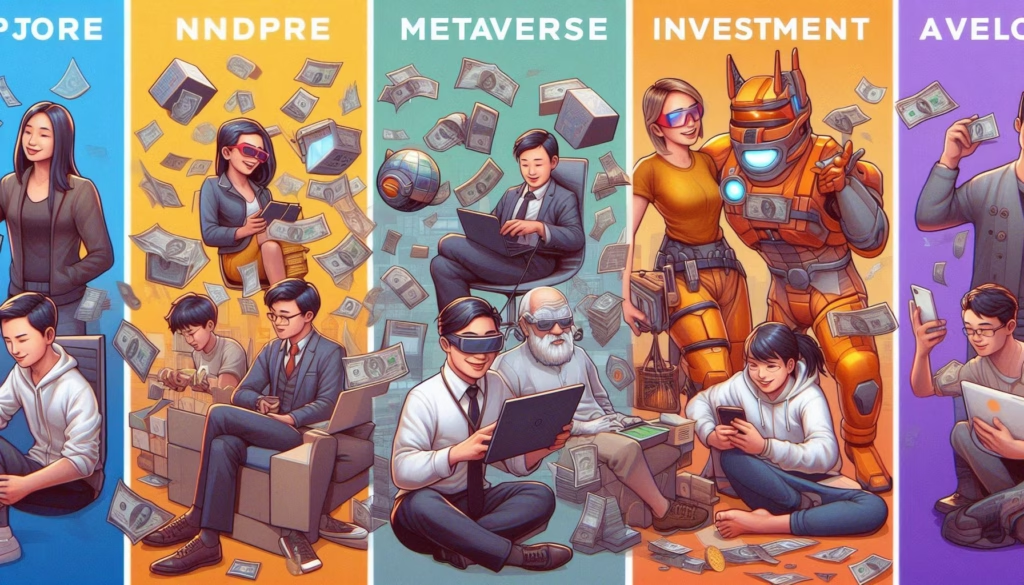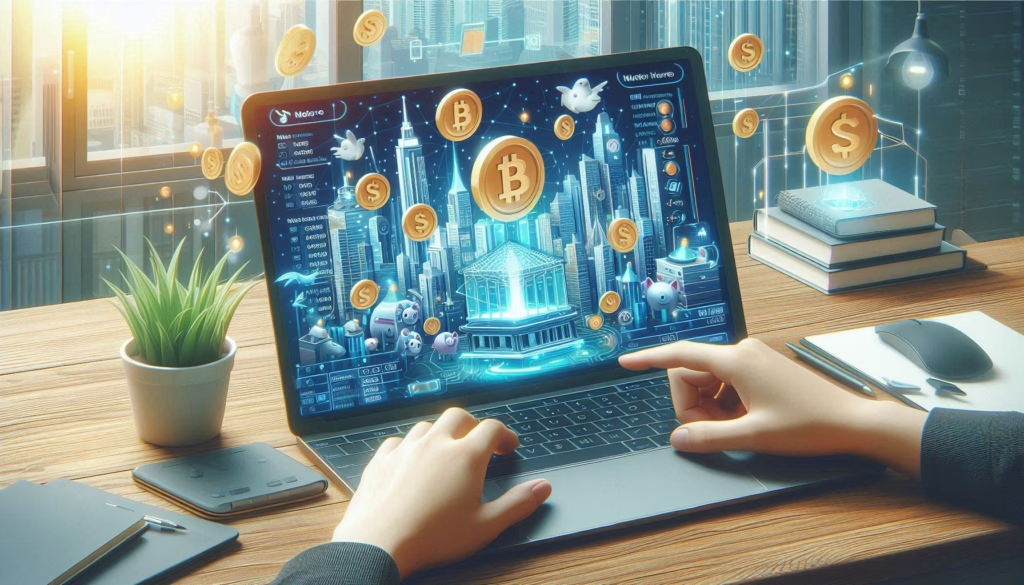Table of Contents
- Overview
- What Is the Metaverse?
- What Is Metaverse Investing?
- Why Invest in the Metaverse?
- The Technologies Powering the Metaverse
- Types of Metaverse Investments
- How to Start Investing in the Metaverse
- Risks and Challenges of Metaverse Investing
- Tax and Legal Considerations
- Security Best Practices
- Future Trends and Outlook
- Frequently Asked Questions
Overview
Imagine owning a virtual apartment in a bustling digital city, attending a concert in a 3D world with friends from across the globe, or running a business in a fully immersive online environment — all without stepping outside your home. This isn’t science fiction. It’s the metaverse, and it’s rapidly transforming how we interact, work, play, and invest.
The term metaverse has exploded in popularity since Facebook rebranded to Meta in 2021, but the concept has been evolving for decades. Today, the metaverse represents a convergence of virtual reality (VR), augmented reality (AR), blockchain technology, artificial intelligence (AI), and digital economies. At its core, the metaverse is a persistent, shared, and interactive digital universe where users can live, work, socialize, and trade — and increasingly, invest.
One of the most exciting aspects of the metaverse is metaverse investing — the practice of allocating capital into digital assets such as virtual land, non-fungible tokens (NFTs), metaverse platforms, and cryptocurrencies that power these virtual ecosystems. As more companies, creators, and investors enter this space, opportunities are emerging that could redefine wealth creation in the 21st century.
But with great opportunity comes great riskRisk Risk is a loss that occurs to the insured individual or object. Various bad possibilities could happen to someone.. The metaverse is still in its early stages. Regulations are unclear, technology is evolving, and market volatility is high. For new investors, diving in without proper knowledge can lead to costly mistakes.
That’s why this comprehensive guide — Metaverse Investing Explained: What You Need to Know Before You Buy — exists. Whether you’re a curious beginner, a tech-savvy enthusiast, or an experienced investor looking to diversify into digital frontiers, this article will walk you through everything you need to know before making your first metaverse investment.
What Is the Metaverse?

Defining the Metaverse
The term metaverse was first coined by Neal Stephenson in his 1992 science fiction novel Snow Crash, where it described a virtual reality-based successor to the internet. In that world, users interacted through avatars in a 3D digital space.
Today, the metaverse refers to a network of interconnected 3D virtual worlds focused on social connection, entertainment, commerce, and productivity. It’s not a single platform but a collective digital space where users can interact with each other and digital environments in real time using avatars.
Think of it as the next evolution of the internet — from a 2D, text-and-image-based experience to a 3D, immersive, and interactive one. Instead of just browsing websites, you’re inside them, walking through virtual stores, attending meetings in digital offices, or exploring fantasy worlds.
What Is the Metaverse? No.1
InsuranceWhat.com
Key Characteristics of the Metaverse
To qualify as part of the metaverse, a digital space typically includes these core features:
- Immersive Experience: Powered by VR headsets, AR glasses, or even standard screens, the metaverse offers a sense of presence — you feel like you’re “there.”
- Persistence: The metaverse never stops. Worlds continue to exist and evolve even when you’re not logged in.
- Interoperability: Ideally, your avatar, assets (like clothes or tools), and identity can move across different metaverse platforms.
- Real-Time Interaction: Users can communicate, collaborate, and transact in real time, just like in the physical world.
- User-Created Content: Anyone can build, design, and monetize experiences — from virtual art galleries to games and events.
- Digital Economy: The metaverse has its own economy, powered by cryptocurrencies, NFTs, and decentralized finance (DeFi), enabling ownership, trade, and earning.
- Scalability: Millions of users should be able to participate simultaneously without lag or crashes.
Today’s leading metaverse platforms—like Decentraland, The Sandbox, and Roblox—offer experiences ranging from art galleries to concert venues. As interoperability standards evolve, avatars and assets may travel seamlessly between worlds, further expanding investment potential.
What Is the Metaverse? No.2
InsuranceWhat.com
The Metaverse vs. the Internet: What’s the Difference?
| Feature | Internet | Metaverse |
| Format | 2D (websites, apps) | 3D (immersive worlds) |
| Interaction | Clicking, scrolling | Moving, gesturing, speaking |
| Presence | Observing content | Being inside content |
| Ownership | Limited (data is centralized) | User-owned (via blockchain) |
| Economy | Centralized (credit cards, banks) | Decentralized (crypto, NFTs) |
| Identity | Usernames, profiles | Avatars with digital assets |
While the internet connects information, the metaverse connects experiences — and it’s built on a foundation that prioritizes user ownership and decentralized control.
What Is the Metaverse? No.3
InsuranceWhat.com
Is the Metaverse Already Here?
Yes and no.
We don’t yet have a single, unified metaverse like in Ready Player One. But pieces of it already exist:
- Gaming platforms like Roblox, Fortnite, and Minecraft host millions of users in shared virtual worlds.
- Social VR apps like VRChat and Meta Horizon Worlds allow users to meet and interact in 3D.
- Virtual events — concerts by Ariana Grande in Fortnite, Travis Scott’s virtual tour — attract tens of millions.
- Digital real estate is being bought and sold in platforms like Decentraland and The Sandbox.
- NFT marketplaces enable ownership of digital art, fashion, and collectibles used in the metaverse.
These are all building blocks of a larger, interconnected metaverse that’s still under construction.
What Is Metaverse Investing?
Defining Metaverse Investing
Metaverse investing refers to allocating capital into digital assets and platforms within the metaverse ecosystem with the goal of generating financial returns. This can include:
- Buying virtual land
- Purchasing NFTs (avatars, art, wearables)
- Investing in metaverse cryptocurrencies
- Supporting metaverse startups or projects
- Earning income through play-to-earn games or virtual businesses
Unlike traditional investing, metaverse investing often involves direct ownership of digital property and participation in decentralized economies.
Why Invest in the Metaverse?
The metaverse combines exponential trends: digital transformation, immersive experiences, and decentralized finance. Here’s why savvy investors are paying attention:
- Explosive Growth Projections Analysts forecast the metaverse market to reach over $800 billion by 2028, driven by gaming, social commerce, and enterprise use cases.
- Early Mover Advantage Virtual land sold for pennies a few years ago now trades for thousands of dollars per parcel.
- Diversification Metaverse assets exhibit low correlation with traditional markets, offering portfolio diversification.
- Novel Revenue Streams From renting virtual property to token staking and play-to-earn gaming, income opportunities are abundant.
The Technologies Powering the Metaverse

The metaverse isn’t magic — it’s powered by a stack of cutting-edge technologies working together. Understanding these is crucial for any investor.
Powering the Metaverse No.1
InsuranceWhat.com
Blockchain and Web3
Blockchain is the backbone of the metaverse economy. It enables:
- Ownership: Digital assets (like land or avatars) are recorded on a blockchain as NFTs, proving authenticity and ownership.
- Transparency: All transactions are public and verifiable.
- Decentralization: No single company controls the entire metaverse.
- Smart Contracts: Self-executing agreements that automate processes like rent, royalties, or sales.
Platforms like Ethereum, Polygon, and BNB Chain host most metaverse projects.
Powering the Metaverse No.2
InsuranceWhat.com
Non-Fungible Tokens (NFTs)
NFTs are unique digital tokens that represent ownership of a specific asset. In the metaverse, NFTs are used for:
- Virtual land parcels
- Wearable avatars (clothes, accessories)
- Digital art and collectibles
- In-game items (weapons, skins)
- Tickets to virtual events
Unlike cryptocurrencies like Bitcoin, NFTs are not interchangeable — each one is one-of-a-kind.
Powering the Metaverse No.3
InsuranceWhat.com
Cryptocurrencies
Metaverse platforms use native cryptocurrencies to power their economies. Examples include:
- MANA (Decentraland)
- SAND (The Sandbox)
- AXS (Axie Infinity)
- WEMIX (Wemade)
These tokens are used to buy land, pay for services, stake for rewards, and participate in governance.
Powering the Metaverse No.4
InsuranceWhat.com
Virtual Reality (VR) and Augmented Reality (AR)
- VR immerses users in a fully digital environment using headsets like Meta Quest, HTC Vive, or Apple Vision Pro.
- AR overlays digital elements onto the real world via smartphones or smart glasses (e.g., Pokémon GO).
These technologies create the “presence” that makes the metaverse feel real.
Powering the Metaverse No.5
InsuranceWhat.com
Artificial Intelligence (AI)
AI enhances the metaverse by:
- Generating realistic avatars and environments
- Powering chatbots and NPCs (non-player characters)
- Automating content creation
- Personalizing user experiences
Powering the Metaverse No.6
InsuranceWhat.com
3D Modeling and Game Engines
Tools like Unity and Unreal Engine allow developers to build rich, interactive 3D worlds. These engines are essential for creating immersive metaverse experiences.
Powering the Metaverse No.7
InsuranceWhat.com
Cloud Computing and 5G
High-speed internet and cloud infrastructure ensure smooth, real-time interactions for millions of users across the globe.
Types of Metaverse Investments

Types of Metaverse Investments No.1
InsuranceWhat.com
Virtual Real Estate
One of the most popular forms of metaverse investing is buying virtual land.
- What is it? Digital plots of land in a 3D world that you can develop, rent, or resell.
- Where to buy? Platforms like Decentraland, The Sandbox, Somnium Space, and Otherside.
- How it works: Land is sold as NFTs, often in auctions or direct sales. Prices vary based on location, size, and proximity to popular areas (like “downtown” zones).
- Potential returns: Investors can:
- Sell land for profit
- Rent it to brands or creators
- Build virtual stores, galleries, or event spaces
- Host advertising or concerts
How to Buy Virtual Land:
- Set up a compatible crypto wallet (e.g., MetaMask).
- Acquire the platform’s native token via exchange.
- Connect wallet to the metaverse marketplace.
- Browse available parcels and review coordinates on the map.
- Place a bid or buy at listing price.
- Confirm transaction and pay gas fees.
Valuation Factors:
- Location: Proximity to high-traffic areas like central plazas and event venues increases value.
- Parcel Size: Larger contiguous plots command higher prices per square meter.
- Neighborhood: Adjacent to high-profile builds (galleries, malls) drives premiumPremium The money that must be paid at a certain time is the obligation of the insurance policyholder. The amount of premium paid is determined by the policy and approval of the insurance company in accordance with the conditions of the insured. The nominal payment approved by policyholders and insurance companies. Premium payment will be made according to the agreement, it can be monthly, yearly, or according to the agreement..
- Utility: Zoning for gaming, advertising, or building rentals can boost ROI.
Example:
- In 2021, a plot of land in The Sandbox sold for $4.3 million to a cryptocurrency exchange.
- The Sandbox’s virtual land along “Fashion Street” appreciated by 250% following partnerships with major brands.
Types of Metaverse Investments No.2
InsuranceWhat.com
Metaverse Cryptocurrencies
Buying native tokens of metaverse platforms is a way to invest in their growth.
- MANA (Decentraland): Used to buy land, goods, and services.
- SAND (The Sandbox): Powers gameplay, land purchases, and governance.
- APE (ApeCoin): Used in the Otherside metaverse by Yuga Labs (creators of Bored Ape NFTs).
- WEMIX (Wemade): South Korean platform with strong gaming integration.
These tokens can be traded on exchanges like Binance, Coinbase, or Kraken.
Types of Metaverse Investments No.3
InsuranceWhat.com
NFTs and Digital Collectibles
NFTs go beyond art — in the metaverse, they represent functional assets.
- Avatar wearables: Digital clothing, glasses, or accessories for your avatar.
- Virtual vehicles: Cars, spaceships, or pets in games.
- Utility NFTs: Items that grant access or abilities (e.g., VIP passes).
- Art and galleries: Digital art displayed in virtual museums.
Tip: Look for NFTs with utility, scarcity, and brand partnerships.
Types of Metaverse Investments No.4
InsuranceWhat.com
Play-to-Earn (P2E) Games
Games like Axie Infinity, Illuvium, and Gods Unchained allow players to earn cryptocurrency by playing.
- Buy NFT characters or items to start.
- Earn tokens through gameplay.
- Sell or trade assets on marketplaces.
While risky, P2E can generate passive income — but beware of “ponzi-like” models that collapse when new players stop joining.
Types of Metaverse Investments No.5
InsuranceWhat.com
Metaverse Startups and Equity Investments
Venture capital firms are funding metaverse startups in areas like:
- VR hardware
- 3D content creation
- Blockchain infrastructure
- AI avatars
Retail investors can sometimes participate through crowdfunding platforms or token sales (IEOs/IDOs).
Types of Metaverse Investments No.6
InsuranceWhat.com
Metaverse ETFs and Stocks
For those who prefer traditional investing, some ETFs and stocks offer indirect exposure:
- Roundhill Ball Metaverse ETF (META)
- Fidelity Metaverse ETF (FMET)
- Stocks: Meta (META), Microsoft (MSFT), NVIDIA (NVDA), Roblox (RBLX), Unity (U)
These are less risky than direct crypto investments but offer less upside.
Pros and Cons
- Pros: Regulated framework, familiar brokerage accounts.
- Cons: Indirect exposure, management fees, slower upside.
How to Start Investing in the Metaverse

How to Start Investing in the Metaverse No.1
InsuranceWhat.com
Educate Yourself
Before spending a dollar, learn:
- How blockchain and NFTs work
- The difference between centralized and decentralized metaverses
- RisksRisk Risk is a loss that occurs to the insured individual or object. Various bad possibilities could happen to someone. of scams and volatility
Recommended resources:
- CoinMarketCap, CoinGecko (crypto data)
- OpenSea, Rarible (NFT marketplaces)
- YouTube channels: Coin Bureau, Ben Armstrong, Crypto Zombie
How to Start Investing in the Metaverse No.2
InsuranceWhat.com
Up a Crypto Wallet
You’ll need a digital wallet to store cryptocurrencies and NFTs. Use separate wallets for trading and long-term holdings.
Popular wallets:
- MetaMask (browser extension, mobile)
- Trust Wallet (mobile)
- Phantom (Solana-based)
- Ledger/Nano (hardware wallets for security)
Always:
- Use strong passwords
- Enable 2FA
- Never share your seed phrase
How to Start Investing in the Metaverse No.3
InsuranceWhat.com
Buy Cryptocurrency
Purchase ETH, MATIC, or BNB (depending on the platform) from exchanges like:
- Binance
- Coinbase
- Kraken
- Crypto.com
Transfer funds to your wallet.
How to Start Investing in the Metaverse No.4
InsuranceWhat.com
Choose a Metaverse Platform
Top platforms to consider:
| Platform | Blockchain | Key Token | Focus |
| Decentraland | Ethereum/Polygon | MANA | Social, events, art |
| The Sandbox | Ethereum/Polygon | SAND | Gaming, creativity |
| Otherside | Ethereum | APE | Immersive world by Yuga Labs |
| Somnium Space | Ethereum | CUBE | VR-focused, persistent world |
| Roblox | Proprietary | Robux | User-generated games (not decentralized) |
| Fortnite | Proprietary | V-Bucks | Entertainment, concerts |
How to Start Investing in the Metaverse No.5
InsuranceWhat.com
Buy Virtual Land or NFTs
- Visit the platform’s marketplace (e.g., market.decentraland.org).
- Connect your wallet.
- Browse available land or NFTs.
- Place a bid or buy instantly.
- Confirm transaction (you’ll pay gas fees).
Pro Tip: Buy land near popular hubs (plazas, galleries) for higher foot traffic and value.
How to Start Investing in the Metaverse No.6
InsuranceWhat.com
Develop or Monetize Your Assets
- Build a virtual store or gallery
- Rent land to brands
- Host events (concerts, conferences)
- Create NFT wearables and sell them
- Stake tokens for passive income
Risks and Challenges of Metaverse Investing

- High Volatility: Cryptocurrencies and NFTs can lose 50%+ of value in days. Never invest more than you can afford to lose.
- Scams and Fraud:
Common scams:
- Fake land sales
- Phishing websites
- Rug pulls (developers abandon projects)
- Impersonators
- Regulatory Uncertainty
Governments are still figuring out how to regulate the metaverse. Future laws could impact:
- Taxation of digital assets
- Ownership rights
- ICO/IDO legality
- Technological Barriers
- VR headsets are expensive
- Internet speed requirements
- Learning curve for new users
- Lack of Interoperability
Most platforms don’t allow asset transfer between them. Your Decentraland wearables won’t work in The Sandbox — yet.
Conduct thorough due diligence and never invest more than you can afford to lose.
Tax and Legal Considerations
- Tax Treatment: In many jurisdictions, trading NFTs and tokens is a taxable event.
- Reporting Requirements: Keep detailed records of date, amount, and value at time of transaction.
- Royalties and Capital Gains: Secondary sales may incur multiple taxable events.
Security Best Practices
- Enable two-factor authentication (2FA) on all accounts.
- Use hardware wallets for storing significant holdings.
- Verify smart contract addresses manually to avoid phishing scams.
- Regularly update software wallets and check for malicious browser extensions.
Future Trends and Outlook
- Interoperability Standards: Protocols like NFT Portals aim to connect assets across worlds.
- Decentralized Identity: Self-sovereign identity (SSI) will let users control data and credentials.
- Enterprise Adoption: Major brands (Nike, Gucci, Adidas) already hosting virtual events and stores.
- On-chain Social Commerce: Buying, selling, and tipping directly within metaverse platforms.
As the technology matures, integration with DeFi, AI-driven avatars, and 5G networks will further accelerate growth.
Frequently Asked Questions
- What is the cheapest way to buy virtual land? Start with niche platforms that have smaller user bases; look for monthly auction events where prices dip.
- Are metaverse assets hedges against inflation? They can diversify portfolios, but high volatility means they aren’t a guaranteed hedge.
- How do I value an NFT? Consider rarity, artist reputation, utility features, and secondary market data.
- Can I rent virtual real estate? Yes. Platforms like Decentraland allow landowners to lease parcels for events or advertising, generating passive income.
- Is metaverse investing sustainable? Energy-efficient blockchains (e.g., Polygon, Solana) are reducing environmental impact. Always check a project’s carbon footprint.
The Conclusion
The metaverse represents a paradigm shift in how we socialize, work, and invest. From purchasing virtual plots of land to collecting scarce NFTs and acquiring governance tokens, this new frontier offers diverse opportunities and novel challenges.
Success in metaverse investing hinges on rigorous research, risk management, and a long-term mindset. By understanding the underlying technologies, choosing reputable platforms, and adhering to security and tax best practices, you can navigate this evolving ecosystem and position yourself to reap the rewards of the next digital revolution.
Embark on your metaverse journey today—and remember that in this virtual realm, information, strategy, and community engagement are your greatest assets.
Do you think you have other ideas about Metaverse Investing Explained: What You Need to Know Before You Buy? You can comment and share your thoughts below, or discuss more in the InsuranceWhat Forum. Also, read more articles about GLOBAL INSURANCE or other interesting insurance topic articles only at InsuranceWhat.com.





